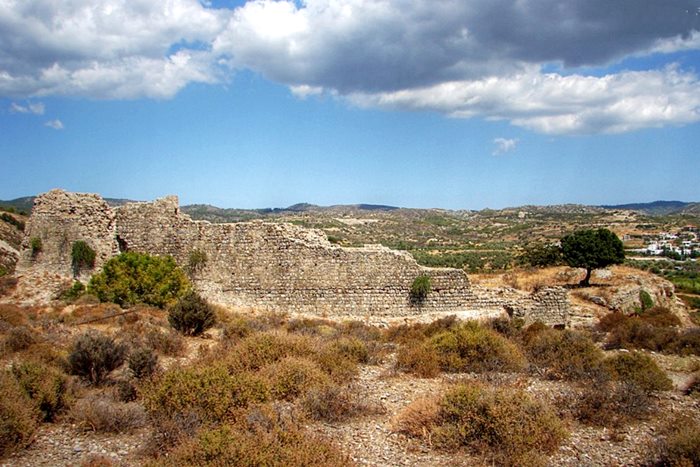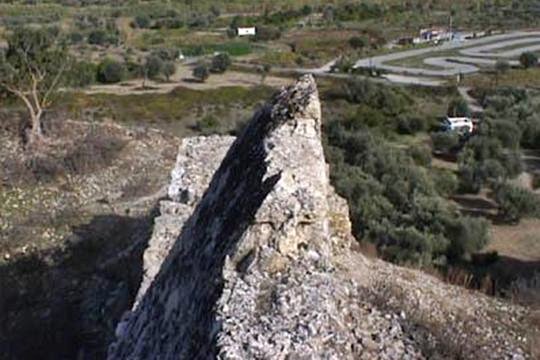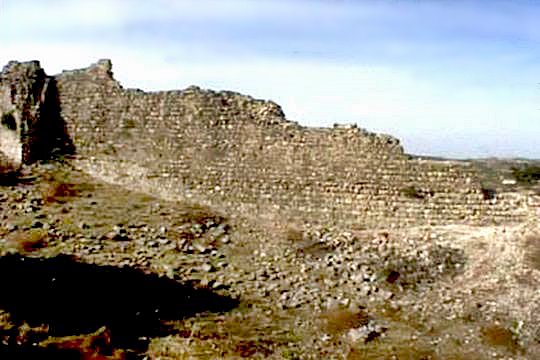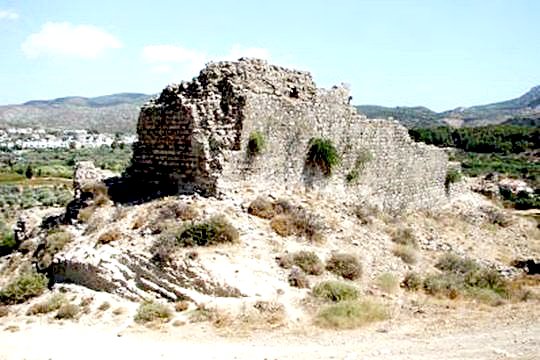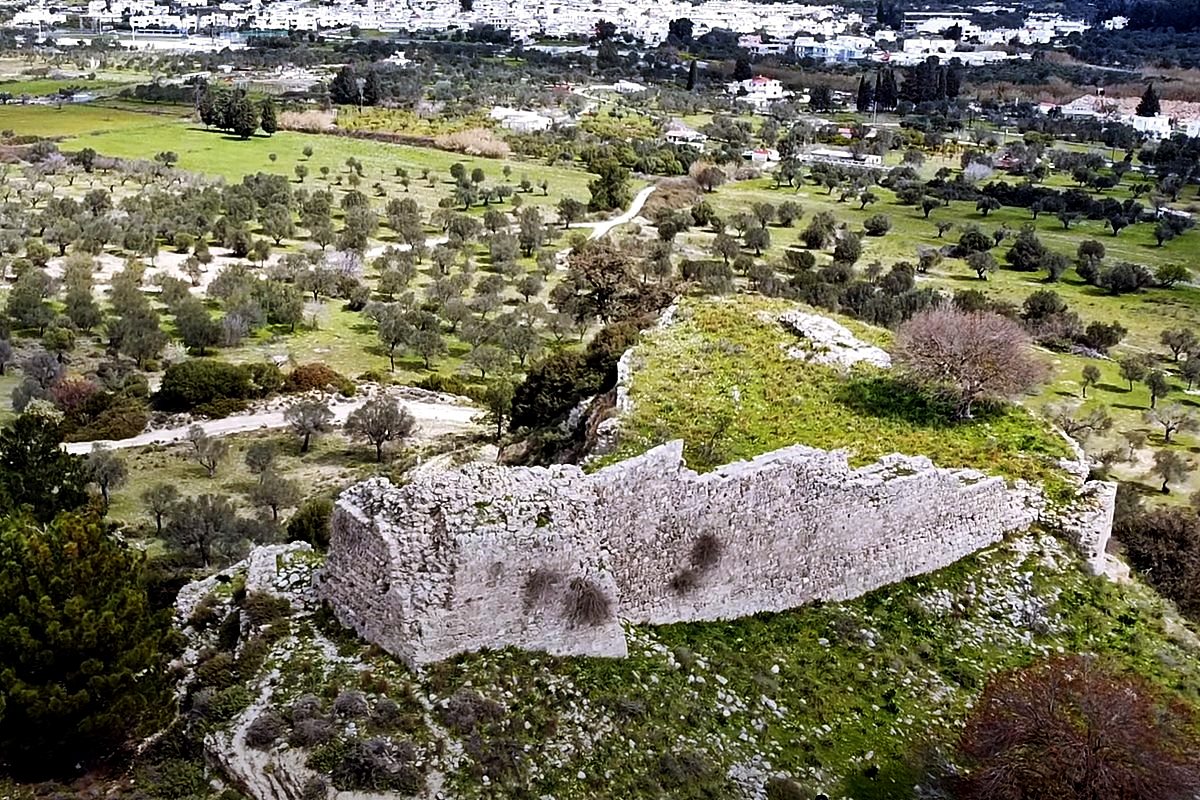Lardos, Rhodes, Dodecanese,South Aegean
Castle of Lardos
| Location: |
| Lardos, near Lindos, Rhodes island |
| Region > Prefecture: | 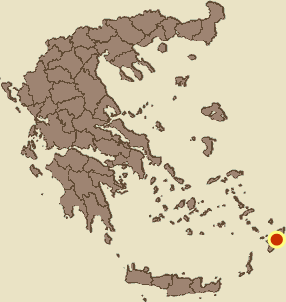 |
| South Aegean Dodecanese | |
| Municipality > Town: | |
| City of Rhodes • Lardos | |
| Altitude: | |
| Elevation ≈ 42 m |
| Time of Construction | Origin | |
| perhaps 14th century | IOANNITE |
|
| Castle Type | Condition | |
| Castle |
In Ruins
|
Ruins of a castle near the village Lardos in Rhodes island. The castle is not mentioned in the archives of the Order of St. John and for this reason there are speculations that it existed before the Knights’ era. This remains unclear.
Castle Description
Text: Dr. Michael Losse – Singen (Hohentwiel), Germany (16.12.2021)General Description
The village of Lardos is located about 4 km west of Lindos, off the coast. A little more than 1 km from the village’s centre, the castle stands on a hill tongue separated from the slightly rising plateau by a moat.
Since the castle stands on unstable ground, after its abandonment there was a loss of substance due to erosion on the castle hill and more recently due to the construction of the road that cuts the hill. Large parts of the enceinte are missing today, but there is only a little wall collapse at the foot of the hill, so stone robbery (for the re-use of the stones as building material) is to be assumed.
On a tongue or a flat spur of a slightly rising plateau stands the castle, elevated by the terrain beyond the strongly deepened road. It thus has a location that could only be defended to a limited extent during an artillery-based siege.
The castle’s irregular layout plan is determined by the location. Above the moat on the south side rises a 30 m long section of the enceinte‘s wall flanked by two square towers, at the foot about 1.65 m thick, which has been preserved up to the height of the 0.5 m thick battlement parapet. The masonry shows various techniques (“half” opus spicatum; Orthostats).
On the west side, the enceinte wall is bordered by a square tower at the highest point of the castle hill with 2.2 m thick walls and flanked on the field side. This tower, which is only connected to the enceinte wall in the lower part and flanked the entrance to the castle, was probably a residential tower; remains of a barrel-vaulted interior are preserved. The smaller flanking tower at the east-northeast end of the wall overlooking the moat is more heavily destroyed.
The northwest side of the enceinte was subsequently secured by a barbican (most probably later 15th or early 16th century).
There is little knowledge about the buildings inside the castle, but it seems that buildings stood on the inside of the south wall, as remains of the wall near the small tower indicate. Next to the main tower there is a barrel-vaulted cistern.
Remains of masonry suggest that there was a counterscarpe in the moat or that the construction of one was started.
History of the castle
The casale Lardos, which the Knights of St. John gave to their ally Vignolo de Vignoli after the occupation of Rhódos in 1307/09, did not include a castle (cf. Spiteri 2001, p. 134, referring to the chronicler of the Order of St. John, Giacomo Bosio II, p. 143), so it remains unclear, if the castle already existed under Byzantine rule.
The founding period of the castle, as well as its architectural history, is unknown. Dr. Stephen C. Spiteri, the Malteses specialist for Knights Hospitallers‘ fortifications, and other authors before him, suspected that it was primarily a refuge for the local people (cf. Spiteri 2001, referring to Gerola 1916, p. 350, and Poutiers 1984, pp. 284-288), but the inhabitants of Lardos were instructed in 1479 to seek shelter at Lindos Castle in the event of war.
Large parts of the enceinte are missing today, but there is only a little wall collapse at the foot of the hill, so stone robbery (for the re-use of the stones as building material) is to be assumed.
Other Info
SourcesGerola, Giuseppe: I monumenti medioevali delle 13 Sporadi. In: Annuario della Scuola Archeologica di Atene e delle Missioni Italiane in Oriente, Vol. I, 1914, pp. 319-356.
Losse, Michael: Die Burgen und Festungen des Johanniter-Ritterordens auf Rhódos und in der Ägäis (Griechenland) 1307-1522. (Publisher: Nünnerich-Asmus Verlag) Mainz 2017.
Poutiers, Jean-Christian: Rhodes et ses Chevaliers (1306-1523). Approche historique et archéologique. Imprimerie Catholique sal Araya, Liban 1989.
Spiteri, Stephen C.: Fortresses of the Cross. Hospitaller Military Architecture (1136-1798). Valleta (Malta) 1994.
Spiteri, Stephen C.: Fortresses of the Knights. Ħamrun (Malta) 2001.
ΣΤΕΦΑΝΙΔΟΥ, Αλεξάνδρα Στ.: Η Μεσαιωνική Ρόδος με βάση το χειρόγραφο και την εικονογράφηση του Johannes Hedenborg (1854). / The Medieval Rhodes. Based on the Manuscript and Illustrations of Johannes Hedenborg (1854). 2004.
| First entry in Kastrologos: | March 2013 | Last update of info and text: | January 2022 | Last addition of photo/video: | January 2022 |
Sources
- Website ΟΔΥΣΣΕΥΣ of the Greek Ministry of Culture – Κάστρο Λάρδου
- Alex Kalantzis , website Κάστρα της Ελλάδας (photo 2)
- Photo 1 courtesy of © Dr. Mathias Piana, Germany, 2007
- Photo 6 (2007) and article (Dec 2021) by Dr. Michael Losse
|
|
| Access |
|---|
| Approach to the monument: |
| - |
| Entrance: |
| Free access |



